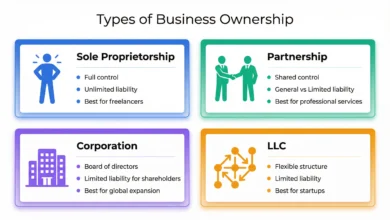From Vision to Venture: A Business Owner Journey

Starting a business is a dream for many, but the journey from a vision to a successful venture is one filled with challenges, lessons, and opportunities. This article explores the key stages of a business owner’s journey, highlighting the essential steps for transforming an idea into a thriving business.
1. The Vision: Where It All Begins
Every business starts with a vision—an idea that sparks a sense of purpose and excitement. For some, it’s a solution to a problem they’ve experienced firsthand; for others, it’s the desire to pursue a passion. But no matter where the idea originates, the vision needs clarity. A well-defined vision gives the business direction and serves as a constant reminder of its purpose.
Key questions to consider:
- What problem am I solving?
- Who is my target audience?
- How will my business stand out in the market?
Defining a clear mission and core values early on not only sets the tone for the business but also helps in decision-making and long-term strategy.
2. Planning: Turning Ideas into Action
Once the vision is clear, the next step is creating a roadmap. This involves detailed planning and research to develop a comprehensive business plan. A well-structured plan outlines the business model, target market, competition analysis, marketing strategy, and financial projections.
Important components of a business plan:
- Market research: Understanding your competition and target market is key to finding your niche.
- Financial planning: Budgeting, forecasting, and determining how much funding is needed to start and sustain the business.
- Marketing and sales strategy: Developing ways to reach and engage potential customers, while setting realistic sales goals.
The planning phase is also when aspiring business owners should evaluate funding options. Depending on the nature of the business, options range from bootstrapping to seeking external investors or loans.
3. Launching the Venture: Taking the Leap
Once the planning is complete, it’s time to launch the business. This is often one of the most exciting and nerve-wracking stages for any business owner. The launch phase includes finalizing logistics like legal structure, securing necessary permits or licenses, setting up operations, and ensuring the product or service is market-ready.
A successful launch requires a strong marketing plan to generate buzz and attract initial customers. Whether it’s a soft launch to a small audience or a big public debut, the goal is to make a memorable first impression.
Tips for a successful launch:
- Build anticipation through social media and community engagement.
- Offer special promotions or deals to early customers.
- Gather feedback from initial users and make adjustments quickly.
4. Growth and Scaling: Moving Beyond the Early Stages
Once the business is up and running, the focus shifts to growth. The first few months or years are often spent refining processes, developing a customer base, and solidifying the business’s position in the market.
Growth requires constant innovation—business owners must be prepared to pivot or adapt based on market demands. Whether it’s expanding product lines, entering new markets, or improving customer service, growth involves calculated risk-taking.
Key growth strategies:
- Customer retention: Keeping existing customers happy is often more cost-effective than acquiring new ones.
- Partnerships: Collaborating with other businesses can open new opportunities and customer bases.
- Investing in technology: Automation and digital tools can streamline operations and improve efficiency.
5. Challenges and Resilience: Navigating the Roadblocks
Every business owner faces challenges, from economic downturns and stiff competition to internal issues like staffing or cash flow management. The ability to stay resilient during tough times is what often separates successful business owners from those who give up.
Common challenges business owners face:
- Managing cash flow, especially during periods of slow revenue.
- Hiring and retaining the right talent.
- Adapting to changing customer behaviors or market trends.
Successful business owners see challenges as learning opportunities. Whether it’s through mentorship, professional development, or simply trial and error, overcoming obstacles builds both confidence and expertise.
6. Sustaining the Vision: The Long-Term Journey
As the business matures, maintaining the vision that sparked the venture becomes crucial. This involves staying true to core values while evolving with the market. Business owners who manage to balance innovation with authenticity often build businesses that stand the test of time.
Long-term success is also about giving back—whether it’s reinvesting profits into the business, mentoring other entrepreneurs, or making a positive social impact. A business that grows sustainably and makes a difference often leaves a lasting legacy.


